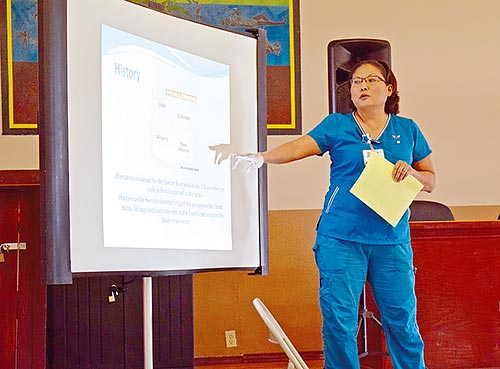
Preventing Hantavirus

Navajo Times | Krista Allen Bertha Yazzie, a community health worker in Coalmine Canyon, Ariz., points out on Jan. 28 that a hantavirus outbreak occurred in the Four Corners about 23 years ago.
Health officials provide steps to properly, carefully clean up after rodents

Navajo Times | Krista Allen
Bertha Yazzie, a community health worker in Coalmine Canyon, Ariz., points out on Jan. 28 that a hantavirus outbreak occurred in the Four Corners about 23 years ago.
TUBA CITY
In the wake of a death from hantavirus in Coconino County, Navajo Division of Health and Tuba City Regional Health Care Corporation have designed a presentation to educate the community and the general public about the virus and how to clean up after rodents.
Coconino County Public Health Services District officials confirmed in January that a county resident died from complications of Hantavirus Pulmonary Syndrome (HPS), an uncommon but very serious type of pneumonia (lung infection) caused by the hantavirus – a virus transmitted by the droppings and urine of infected rodents, most often deer mice.
“Hantavirus is carried in the urine, the saliva, and in the feces of infected rodents such as rats, (mice), squirrels, (hamsters), and (their relatives),” Bertha Yazzie told the people last Thursday who attended the presentation at Tónaneesdizí Chapter.
Yazzie, a community health worker in Coalmine Canyon, Ariz., said the virus in Navajo is “na’ats’ǫǫsí bits’ą́ą́dóó na’ałniihí.” And anyone who comes in contact with rodents that carry the virus is at risk of infection.
“(Infection) happens when (droppings and urine of infected rodents) is stirred up in the air (airborne transmission),” Yazzie explained. “If you touch the rodent droppings, urine, nesting … with your bare hands and touch your eyes, your mouth, you can get the virus.”
According to the Harvard Medical School Family Health Guide, infection begins with fever, headache, muscle aches, cough, dizziness, and shortness of breath. Sometimes gastrointestinal symptoms such as nausea and vomiting occur.
“If you feel these symptoms, go to the hospital, seek help as soon as possible,” Yazzie said.
Infected people, according to the Guide, then experience a rapid heart rate, low blood pressure, and lung symptoms such as cough, fluid in the lungs, and pain, which leads rapidly to shock and respiratory failure (inability to breathe).
Rebecca Hoshnic, a community health worker here, said those are the late symptoms.
Cases of HPS occur sporadically, according to the Centers for Disease Control and Prevention. Usually in rural areas where forests, fields, and farms offer suitable habitat for the virus’s rodent hosts.
Yazzie said barns, outbuildings, and sheds are potential sites where people may be exposed to the virus.
While airborne transmission is one way to get infected, there are several other ways rodents may spread hantavirus to people, including if a rodent carrying the virus bites someone and if one eats food contaminated by droppings, urine, or saliva from an infected rodent.
But there are ways to prevent it.
“If you have any holes in your house, (including) cracks, big openings, you need to seal it up or use weather strips,” Yazzie urged. “Mice can come in anywhere, the very smallest holes. Have traps set up around your home. And keep your home clean.”
“Get rid of all indoor and outdoor junk,” she continued. “Keep your hay and woodpile far from the home. And garbage cans, make sure they have lids that fit tightly.”
To clean up after rodents, the CDC suggests to trap the rodents for at least a week and to seal up any entryways to ensure that no rodents can get in.
If no rodents are captured, the active infestation has been eliminated and enough time has passed so that any infectious virus in the rodent’s droppings, urine, and nesting material is not longer infectious.
Yazzie says before cleanup, ventilate the space by opening the doors and the windows for at least 30 minutes to allow fresh air to enter the area.
“Do not sweep or vacuum up (droppings, urine, or nesting materials),” Yazzie said. “That’s just going to spread it up into the air.”
The CDC suggests wearing rubber, latex, or vinyl gloves when cleaning droppings, urine, and nesting materials.
Yazzie says to spray the area with a disinfectant or a mixture of bleach and water, and let soak for about 15 minutes. The recommended solution is 1 part bleach to 10 parts water.
“Clean the site,” Yazzie said. “Use paper towels or rags that are disposable, (and dispose of the waste in heavy-duty plastic bags.”
The Hantavirus is named for the Hantan River in South Korea where an early outbreak was observed. The virus was isolated in the late 1970s by virologists Karl M. Johnson and Ho-Wang Lee.
HPS has been endemic in the Americas for at least several decades, according to The Journal of Infectious Diseases. It is hypothesized that the 1991-1992 El Niño – Southern Oscillation caused increased precipitation that allowed an increase in rodent population densities, increasing the possibility of transmission to humans.
The result was a 1993-1994 outbreak of the disease in the Four Corners. A caseload of HPS increased five-fold in that area in 1998-1999.
To read the full article, pick up your copy of the Navajo Times at your nearest newsstand Thursday mornings!
Are you a digital subscriber? Read the most recent three weeks of stories by logging in to your online account.








 Highway 264,
Highway 264, I-40, WB @ Winslow
I-40, WB @ Winslow